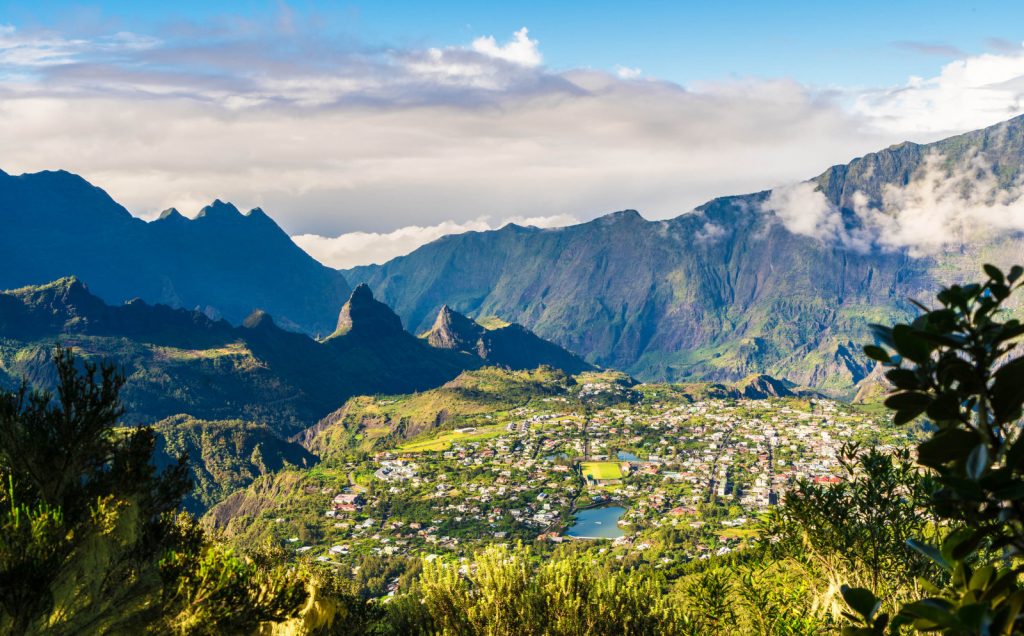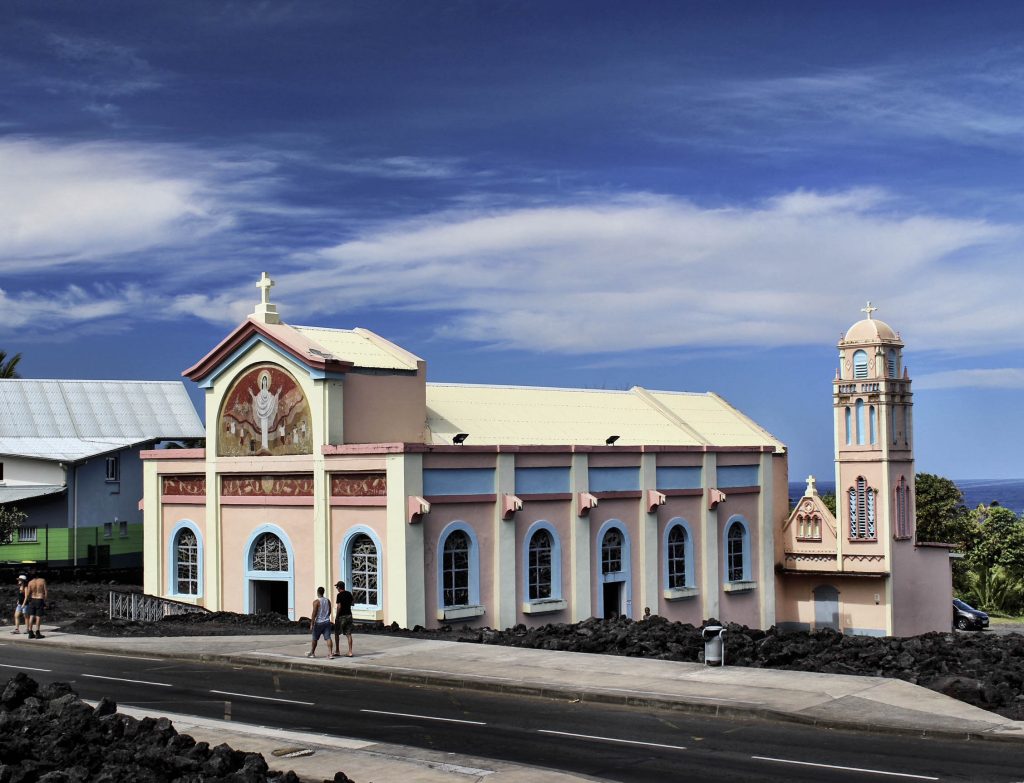The Boucan Canot beach, Cirque de Mafate and the hiking trail into the volcano Piton de la Fournaise on Réunion island, which is a few hours away from South Africa by plane. Photos: Getty Images
Whether you’re Covid-weary or just longing to disconnect from everything, chances are you’re craving a change of scenery. What could be better than decamping to a remote island a stone’s throw from the motherland?
Voilà Réunion, a little piece of France in the Indian Ocean just four hours from Joburg. From the enamel road signs in the capital Saint-Denis to the lyrical lingo and towns and cities that display elements of French colonial architecture, gastronomy and customs, Réunion channels the greater République in myriad ways.
A trio of Cirques
Réunion’s turbulent birth gave rise to a peaky mountain massif characterised by fissures, ravines and pleated crevices, an outdoor playground with prize conditions for canyoning, paragliding and inter-cirque trekking expeditions.
With around 1 000km of established trails, hiking is high on the agenda. About 120 trails crisscross the island’s cirques through unspoilt territory. The interior is a national asset and a helicopter flip delivers an epic perspective.
Piton des Neiges (Snow Peak), the dormant volcano in the centre of Réunion, is the highest point, both of the island and in the Indian Ocean. It is deeply eroded and surrounded by three deep craters — Cirque de Mafate, Cirque de Salazie and Cirque de Cilaos, each with communities residing on the low slopes.
 Cirque de Cilaos.
Cirque de Cilaos.
Only 800 people live in Mafate and they’re spread across 12 self-sustaining, off-the-grid hamlets called îlets, which can only be reached on foot or by air.
Salazie, with its misty microclimate, is spectacular, with more than a hundred waterfalls, and is the frontrunner for the most naturally beautiful of the three cirques.
Quaint Cilaos, meaning “the place you never leave” in Malagasy, is a plateau town framed by the precipitous cliffs of the Piton des Neiges.
If you love mountain passes, the RN5 from Saint-Louis will delight with its tunnels and hairpin bends — 430 of them! It’s a tad hair-raising in parts and best negotiated with an experienced local at the wheel. The town, which dates back to the 1930s, is dominated by the revered Notre Dame des Neiges. Cilaos is famous for its hospitality, thermal springs, embroidery, fruity wine, lentils and forest walks.
Road tripping
Circumnavigating the 70km-by-50km island is a cinch, easily done by automobile in four hours on a straight run. But a coastline of 207km comes with tons to see, so take your time.
Take a ramble through Saint-Pierre and slot the Domaine du Café Grillé into your itinerary for double-shot flat whites, gifts and a lush garden that will blow your hair back with its floral exotics.
Marché Couvert, the indoor market, peddles must-haves such as rum and vanilla products as well as speciality artisanal goods.
Driving along the coast nets the blackened basalt cliffs at Le Cap Méchant in the Wild South (Sud Sauvage), shaped by aeons of wave action. Half an hour later you’ll find yourself heading inland through the agricultural hub of Saint-Benoît, dense with cryptomeria woodland, grazing cows and apple-green meadows reminiscent of Switzerland.
Volcanoes
Route du Volcan begins in the village of Bourg-Murat, leading to Piton de la Fournaise. Unmissable sights on the way include the Nez de Boeuf lookout at the Vallée de la Rivière des Remparts and the Commerson Crater, a gaping maw filled with swirling vapour — mysterious and a little creepy up close.
The visual pièce de résistance on this route is the viewpoint over the bronzed earth of the Plaines des Sables, a barren flatland intersected by a single road that cuts a clean stripe through the desert terrain and ends at the Pas de Bellecombe.
All walks and hikes to Piton de la Fournaise, an active hot-spot volcano, begin here, although not everyone opts to go the distance, preferring to end their tour at Formica Leo, the first of several low-profile craters. Visit before 11am when, like clockwork, low clouds roll in and visibility is greatly reduced, although the path is well marked.
Getting to Formica Leo requires a walk down hundreds of steps, a descent that takes 30 minutes and is a thigh-burner on the way back up.
Piton de la Fournaise (Peak of the Furnace) on the uninhabited side of the island is the fiery star attraction which has seen more than 150 eruptions since the 17th century. Like Piton des Neiges, it’s in Réunion National Park, covering 40% of the island and holding Unesco World Heritage status.
Fournaise is a shield volcano, so named for its broad, flat shape caused by centuries of compacted magma and the fact that it oozes lava, rather than blowing its top like a cone volcano.
Avid climbers will relish a guided night hike to watch the sparks fly up close. The volcano can be reached by car, 4×4, Segway, mountain bikes, motorbikes and even on horseback.
Those who don’t mind drenching humidity and leopard-crawling, slap on a helmet and go spelunking through the underground lava tubes at Le Grand Brûlé. It’s a challenge for claustrophobes, so if that’s you, leave the cavers to it and visit the waterfalls and palm plantations at nearby Anse des Cascades.
Beach time
Tropical islands and beach time go hand in hand, although Réunion is less of a resort island than the neighbouring islands of Madagascar, Seychelles and Mauritius.
The Natural Marine Reserve extends along 40km of coastline and coral reefs, protecting a thriving ecosystem of more than 3 500 species. The elephant in the room here is recurring shark attacks but stick to the rules, look out for zone X marker boards that signal safe beaches with shark nets, and you’re good to go.
Because of the fragility of marine life, jet skiing, fishing and kayaking are carefully monitored. Surfing and bodyboarding remain popular and one of the best places to jump on a board is at Plage de Boucan Canot, an enticing beach with white sands, palm trees, bars and restaurants.
L’Hermitage on the west coast is a lagoon paradise with crystal-clear shallows for excellent snorkelling, and chill spots under filao pines.
 Notre Dame des Laves in Sainte-Rose showing where lava bypassed it. Photo: Allison Foat
Notre Dame des Laves in Sainte-Rose showing where lava bypassed it. Photo: Allison Foat
Cuisine and picnicking
Creole food is a culinary representation of the many nationalities of Réunion society. Pei, or local cuisine, recalls the cultures of Réunionese society. Think spices from India, roots and herbs from Africa, stewing methods from Europe and the umami flavours of Asia.
Cari is the regional speciality — fish, meat or poultry simmered in turmeric, ginger, curry and garlic, while palm-heart salad, prawns and lentils are favourites.
Restaurant food is commonly served buffet-style, encouraging patrons to sample everything and cost-wise you’re looking at about €20 to €25 (about R400) at an inexpensive eatery, without a bottle of wine, which will add about €7 to the bill.
Picnicking is a cherished weekend ritual and Réunionese take their alfresco feasting seriously, setting up outdoor kitchenettes at every opportunity, complete with gas cookers, fold-out chairs and long tables laden with traditional specialities.
Roaming chefs like Willem Robert of Anime Pique Nique are adept at conjuring up authentic meals in diverse locations. Name the place and he’ll sort the spread. His interactive cooking classes are an excellent way to expand your recipe repertoire.
Réunion certainly lives up to its hashtag — #theultimateisland.
Guide
Currency: Euro (17-1)
Getting there: Air Austral via OR Tambo in Johannesburg www.air-austral.com. From the airport, book a shuttle to your hotel that comes with a professional guide, and Sully Chauffre of Ethnix Tours is highly recommend: www.ethnixtours.com
Picnics: Anime Pique Nique: https://www.facebook.com/willempatrice974/
Cool upcoming events: The Créole Festival in October 2022 and Le Fête Caf in December that celebrates the abolition of slavery.
Helicopter flip: www.corail-helicopteres.com costs from 12 0Euro depending on duration